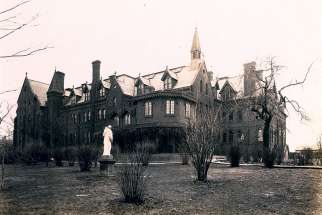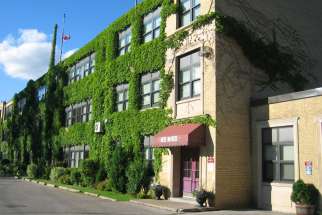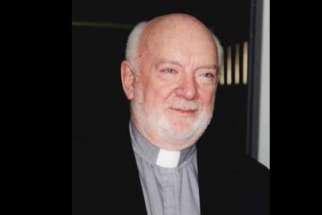A history defined by Catholic charity
Catholic charity and the spirit of giving, regardless of a recipients’ religious affiliation, have been instrumental in shaping Toronto’s social, health care and political history through three centuries.
The Greater Toronto Area would be a vastly different place today without the fundamental commitment to charity that was mobilized in the archdiocese’s earliest days.
“We tend not to be boastful, but you have to get up and tell this story sometimes,” says Michael Fullan, executive director of Catholic Charities of the Archdiocese of Toronto. “It’s that important. And it’s not the work of my office, it’s the work of our member agencies.”
Catholic Charities, an umbrella group for 26 individual charitable organizations, was the brainchild of Archbishop Neil McNeil in 1913. But Catholic giving has been making its mark around Toronto for as long as the archdiocese has existed, perhaps longer. And so many different people have contributed, from bishops, priests and nuns to lay people, volunteers and administrators.
An interesting example of Catholic charity impacting both society and politics sits in the west end overlooking Lake Ontario and seen by thousands of commuters every week. Today it’s known as St. Joseph’s Health Centre, but it started as an orphanage and evolved into a first-class hospital due to the quick wits and vision of the Sisters of St. Joseph, who arrived in Toronto in 1851.
The Sacred Heart Children’s Orphanage — known as Sunnyside Orphanage — began around the time of Confederation to ease the overcrowding at the House of Providence on Power Street, which opened in 1857. (It moved to Scarborough in 1962 as Providence Villa and today is known as Providence Healthcare.)
At the House of Providence in the 1870s, about 300 orphans and several hundred poor and elderly adults, many so-called “incurables,” were being looked after by the Sisters of St. Joseph, nicknamed the “Sisters of Charity.” Despite best efforts, conditions would have been desperate, especially for children living amongst the dying.
“There was a large oven where the sisters baked bread for the children,” says Fr. Seamus Hogan, Assistant Professor of Church History at St. Augustine’s Seminary and an expert on the early bishops of the Archdiocese of Toronto. “The locals would say the oven was never cool to the touch.”
To ease the overcrowding, the Sunnyside Orphanage was opened in a large four-storey rented house owned by prominent 19th-century Toronto architect and developer John George Howard. In 1881, the nuns and the archdiocese bought the property, expanded it to both boys and girls a decade later, and served the needs of at-risk kids and orphans for three decades. But then, in the early 20th century, the city’s rapid expansion put the orphanage at risk. The sisters used political guile to outfox the politicians.
“In typical fashion,” notes the Toronto Historical Association website, “the City of Toronto decided to expropriate the property for use as a school in the growing residential area. To prevent the expropriation, the Sisters of St. Joseph and the diocese decided to convert the property into a hospital, which could not be expropriated.”
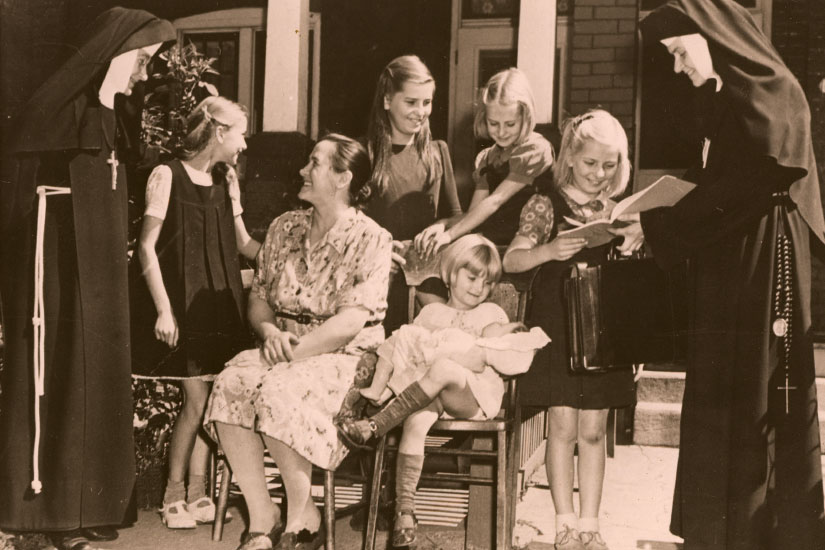 A couple of Felician sisters makes a social service call to a Toronto family. (Photo courtesy Archives of the Roman Catholic Archdiocese of Toronto)
A couple of Felician sisters makes a social service call to a Toronto family. (Photo courtesy Archives of the Roman Catholic Archdiocese of Toronto)
The orphanage was moved and in 1921 an important health care facility came to the west end. This was not the first political tussle for the Sisters of Charity. In 1892 they founded St. Michael’s Hospital. The next year, the city’s fathers wanted to withdraw grants to the hospital, in part by questioning the medical qualifications of the sisters. For help, they called upon Archbishop John Walsh, a likeable and dignified man who was not one “to inflame sectarian feeling or to embitter the relations between Catholic and Protestant,” as the Globe reported.
“If the occasion arose, however, Walsh was certainly capable of venting his anger,” writes Michael Power (not Toronto’s first bishop) in the Dictionary of Canadian Biography. “In June 1893, when municipal politicians withdrew grants from all sectarian hospitals (including St. Michael’s), the archbishop dispensed with diplomacy and immediately responded with a scathing denunciation. In a brilliantly argued circular letter published in The Catholic Register, he vigorously defended the right of all hospitals to a share of public money. Within a week, the city council had reversed its decision and restored the grants.”
In his letter, Walsh called the city council’s actions “blind and brutal bigotry…. We must enable it to keep its doors wide open for the sick and poor, whether Catholic or Protestant. No child of misfortune of any creed or colour must ever be refused its sacred hospitality when suffering from the pangs of disease.”
Today, St. Michael’s is celebrating its 125th anniversary and remains a vital health care provider in the heart of Toronto.
Throughout the 19th and early 20th centuries, there was much Catholic charity in the diocese; beginning with the first bishop, Michael Power, whose ministering to the ill in the typhus “fever sheds” cost him his life. The second bishop, the unheralded and underrated Armand de Charbonnel, launched many charitable initiatives: founding the Toronto Savings Bank to help the poor save their money, bringing the St. Vincent de Paul to Toronto and spearheading Providence. The latter two still exist today, helping thousands every year.
“Charbonnel, although from a rich family, would join lay people visiting the poor in their homes. This was a powerful message of trying to be in solidarity with the poor,” Hogan said.
Succeeding Charbonnel was Bishop John Lynch, whose episcopal motto was, “He has anointed me to proclaim good news to the poor.” He worked with the Sisters of St. Joseph in expanding Providence House, creating the St. Nicholas Home for Working Boys, founding the Sunnyside Orphanage for boys and establishing the Notre Dame Institute, a boarding-home for working girls and female students.
Following Bishop Lynch was Bishop Walsh, who, beyond saving public money for hospitals, founded the St. Vincent de Paul Children’s Aid Society of Toronto in 1894, the forerunner of Catholic Children’s Aid Society.
By the time Neil McNeil was named archbishop in 1912, those in need were being served by many well-established Catholic organizations. But Archbishop McNeil understood the delivery of services could be uneven, and there was no central body to oversee individual charities while keeping the chancery office informed and making long-range plans to meet future needs.
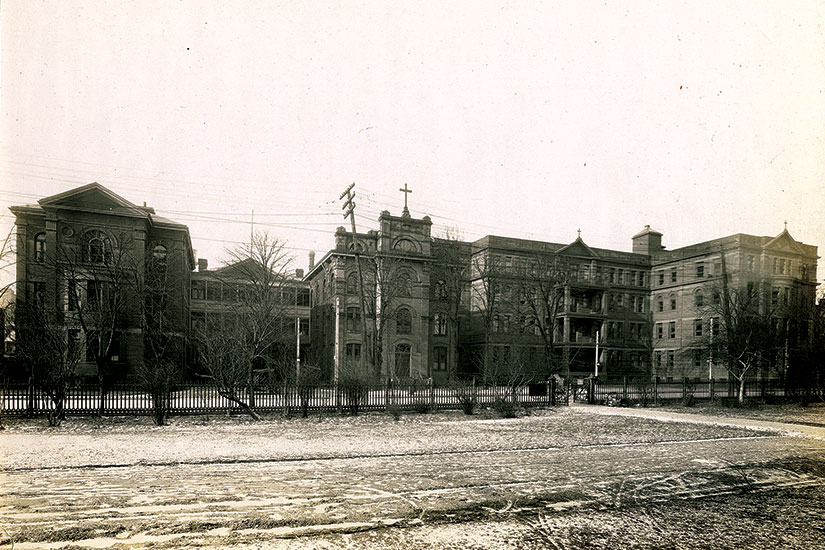 St. Michael’s Hospital, circa 1914, was established by the Sisters of St. Joseph in 1892. (Photo courtesy Archives of the Roman Catholic Archdiocese of Toronto)
St. Michael’s Hospital, circa 1914, was established by the Sisters of St. Joseph in 1892. (Photo courtesy Archives of the Roman Catholic Archdiocese of Toronto)
It was visionary thinking. Over the years, as the face of the archdiocese has changed, Catholic Charities has changed with it, ensuring that services meet existing needs while anticipating future ones.
What has remained unchanged, however, is the mandate at the heart of Catholic Charities: “Not only do we allocate the funds that ShareLife raises, but we also hold our agencies accountable for the provision of services within the Catholic tradition,” Fullan says.
At its core is Catholic social teaching focused on the poor and marginalized, urging citizens to build a just society and safeguard the dignity of every person. Bishops Power, Charbonnel, Lynch, Walsh and McNeil laid the groundwork that continues decades later.
For example, to ensure gaps were getting plugged and services were of the highest quality, in 1913 Archbishop McNeil appointed Fr. Patrick Bench superintendent of the newly created Catholic Charities. Regular reviews of each agency for “good practice and good Catholic practice” continues to this day, Fullan says.
There have been many challenges, of course, and, as is often said, history repeats itself. For instance, until 1919 individual charities were on their own in terms of fundraising. Then Catholic Charities shifted its operations with the formation of the Federation of Community Service to pool fundraising efforts. It was the forerunner of the United Way and various religions worked together to raise money for the greater good. It was very effective, resulting in a dramatic increase in funding for member agencies.
Then, to ensure the right services were getting to the people who needed them most, Archbishop McNeil commissioned an archdiocese-wide needs assessment. The results led to the creation of the Catholic Welfare Bureau, which was responsible for providing services for Catholic Charities, including family and child care services. Unfortunately, the fundraising benefit of the Federation of Community Service would last less than a decade. In 1927, the federation announced Catholic agencies and institutions would not be eligible to receive any funds in the coming campaign.
Was it the same anti-Catholic bigotry that threatened St. Michael’s Hospital almost 35 years earlier? Explanations for the decision vary. But the fact is Catholics, by and large, were poorer, made up of more immigrants and in need of social services more than others. That means they requested more of the money raised.
Archbishop McNeil, stunned by the decision, acted quickly and turned to the Catholic community for help. Along with religious and lay leaders, the archbishop launched the Federation of Catholic Charities, a reorganized version of Catholic Charities that included a fundraising component. In three weeks, almost $200,000 was raised.
(This “going alone” strategy would be a valuable precedent nearly 50 years later for Archbishop Philip Pocock when he established ShareLife. More on that later.)
The Great Depression of the 1930s stretched Catholic Charities to the limit, prompting salary cuts, services being triaged and budget tightening. But again, Catholics stepped up and staff at member agencies and a fleet of volunteers rose to the challenge of tough times, while those in the pews gave what they could to make it through those lean years.
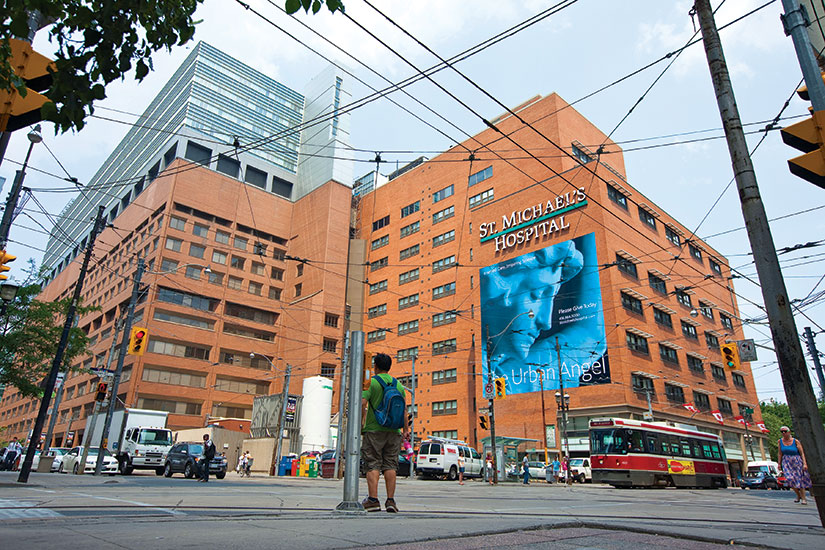 St. Michael’s Hospital today is a major teaching and research medical facility. (Photo courtesy St. Michael’s Hospital)
St. Michael’s Hospital today is a major teaching and research medical facility. (Photo courtesy St. Michael’s Hospital)
With the end of the Depression came World War II and a united front against a common enemy. The city even saw a return to a unified charitable effort with the creation of the United Community Fund, the precursor to today’s United Way. It was such a success that Catholic Charities was able to raise salaries, expand services and improve agency facilities.
After the war, the federation, now operating under the name the Council of Catholic Charities, found a new director in Fr. John Fullerton (later Msgr. Fullerton). Known for his people skills, he had the diplomacy and intelligence needed to negotiate budgetary issues with the United Community Fund, as well as handle increasing negotiations with the provincial government.
In a clear indication of Catholic Charities’ increasing public profile, Fr. Fullerton was asked to serve as vice-chair of the three-person Ontario Hospital Services Commission.
In this role, his recommendations contributed to legislation that led to the eventual creation of OHIP, Ontario’s public health insurance plan.
For Catholic Charities, life was good for many post-war years with an expansion of amenities such as the establishment of Sancta Maria House, a home for girls with special needs, and many other needed social services for the poor and marginalized. But a crisis of thunderbolt proportions appeared in 1976. The United Way voted to admit the Planned Parenthood Association of Toronto, a group offering abortion counselling.
Planned Parenthood’s admission represented only a sliver of United Way funding, but its mere presence was an insurmountable obstacle for Catholics. After negotiations between United Way and Archbishop Pocock proved fruitless, the Council of Catholic Charities withdrew from United Way. To replace the lost funding, ShareLife was launched. No doubt, Neil McNeil’s need to go alone in 1927 gave Archbishop Pocock further confidence for ShareLife’s future success.
Today, the Archdiocese of Toronto is Canada’s largest diocese, stretching north to Georgian Bay and from Oshawa to Mississauga with almost two million Catholics. Catholic Charities this year will allocate $9.1 million to its member agencies to serve more than 200,000 people from downtown Toronto to Durham Region to Simcoe County to Dufferin-Peel.
For Catholic Charities, things are much different than in Neil McNeil’s time, but the philosophy of working together to best serve the poor and needy remains the same.
“I’ve been saying we need to do more together differently,” Fullan says, adding that shared services such as financial management and HR support have been a boon to its member agencies.
Later this year, once a pilot project is completed, shared IT support should be rolled out to all 26 agencies, Fullan says, enabling smaller agencies to take advantage of services they might not otherwise be able to afford, and ensuring that money given to ShareLife can be stretched as far as possible.
It also proves, once again, that even as times and needs change, the spirit of Catholic charity remains the same throughout the archdiocese.
Students introduced to hands-on renewables
TORONTO - To encourage his students to start thinking about the environment of tomorrow today, technology teacher Joe Ferro has brought renewable energy into the classroom at Neil McNeil High School.
Jim’s death diminishes me, but also gives me strength
Some weeks ago, I mentioned an inevitable goodbye that would take place with a dear friend whom I met on the first day of Grade 9 at Neil McNeil High School in Toronto’s east end 40 years ago next week.
World travelling Fr. Doyle called Toronto home
TORONTO - Fr. Michael Doyle, a Spiritan priest who served around the world but called Toronto home, has died. He was 82.
Fr. John D. Geary was happiest in the classroom
TORONTO - As he lay dying, Spiritan Father John D. Geary didn’t just listen to classical music on the stereo in his room, he conducted the invisible orchestra.
Jesus found on the periphery, bishop tells students
TORONTO - Look to the peripheries for it is there you’ll find the suffering, the marginalized and Jesus Christ.


